
In this activity, students will play the game heads up with vocabulary covered throughout the semester to review for the final exam.
- Subject:
- Arts and Humanities
- Languages
- Material Type:
- Activity/Lab
- Date Added:
- 05/06/2019

In this activity, students will play the game heads up with vocabulary covered throughout the semester to review for the final exam.

In this activity students will practice discussing their likes, dislikes, and hobbies. Students will play charades to help reinforce vocabulary. Students will then use the charades cards to discuss their favorite hobbies and ask one another about which hobbies and activities they enjoy.
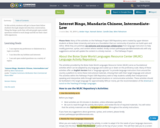
In this activity students will get to know their fellow students through simple introduction conversation. Using the bingo cards they will ask people open ended questions related to each image and fill out their chart with signatures.
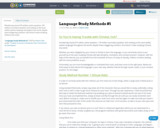
Numbering nearly 873 million native speakers, 178 million secondary speakers and ranking as the most widely spoken language throughout the world, despite these staggering numbers, this doesn't make studying Chinese any easier.

This online textbook represents materials that were used in the first four semesters (two years) of the Mandarin program at MIT. They eventually formed the basis of a print textbook of the same name, published by Yale University Press. The OCW course materials were extensively revised, and at times reordered, before publication, but the general principles of the original remain: to provide a comprehensive resource for the foundation levels of the Chinese language that separates the learning of oral skills from literary (the former being transcribed in pinyin, and the latter in characters). This resource contains the complete online version of the text and accompanying audio recordings.

In this activity, students will plan a menu for a Chinese New Year’s Eve dinner using clues about individual dishes cultural significance. Students will read aloud the descriptions of the dishes, and then choose which ones they would want to include in their banquet to best align with traditional Chinese New Years Eve conventions.
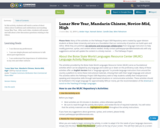
In this activity, students will watch a series of short videos about traditions and celebrations surrounding Lunar New Year . After each video, students will answer and talk about a few discussion questions relating to the videos.

In this activity students will learn vocabulary associated with different times of day. Students will each be given a name game card of a famous Chinese icon. Students will then take on the role of these icons and introduce themselves to one another and practice greetings.

In this activity students will respond to discussion questions about dating and dating experiences. Discussion questions will not only cover student’s experiences, but also their opinions about the best places to go on dates in their city.

In this activity students will learn about various natural disasters. Students will begin by watching a few news videos about natural disasters in Taiwan, then go through scenario cards discussing how they would handle certain disaster situations.
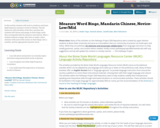
In this activity students will work to reinforce and learn high frequency measure words in Chinese. The lab instructor will roll either of the dice, and then the students will choose and image on their bingo cards that corresponds with the measure word shown. After a student achieves a bingo, they have to make a short sentence with each of the nouns on their bingo card, a number, and the appropriate measure word.
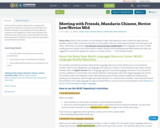
In this activity students will practice creating short narratives in Chinese by creating a mad-libs like story. Students will take turns picking cards from different categories to fit together in a short story. Students will then share their short story out loud. Students will also read invitations for different types of parties and answer comprehension questions.

In this activity students will view a few music videos from various Chinese artists in different musical genres. After each video, students will engage in a short discussion about similarities and differences in the genres between American and Chinese music.
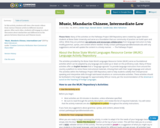
In this activity students will view a few music videos from various Chinese artists in different musical genres. After each video, students will engage in a short discussion about similarities and differences in the genres between American and Chinese music.
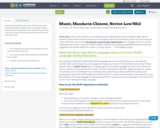
In this activity students will view a few Chinese music videos from different genres. After viewing the videos, students will use information provided about each artist to do a mini research presentation in Chinese about the artist they chose.

Since the mid-l970s, economic reforms have transformed China from one of the most egalitarian societies into one of the most unequal in the world. Wide disparities currently exist between the income levels of a relatively few rich and middle-class Chinese and their fellow citizens who number in the hundreds of millions. This "wealth gap" is particularly acute when one compares the incomes of urban and rural residents, between Chinese living in the interior of the country and those living in the rapidly developing cities on China's eastern coast.The causes of the growing income gap include previous governmental policies that favored city dwellers over farmers, the uneven regional patterns of foreign investment, and the massive outflow of displaced farmers to China's already overcrowded cities in pursuit of manufacturing jobs.Recently, the Chinese government, in recognition of the potential for social instability, and in the face of growing unrest amongst China's poor, has made the elimination of economic and social inequalities a top priority. Plans are in motion to build a more "harmonious society" through the delivery of improved educational and health services to those who appear to have been left behind in China's rush to modernize its economy.This lesson, using clips from the WIDE ANGLE film "To Have and Have Not" (2002), can be used after a lesson on the Communist Revolution and Mao's rule. A basic knowledge of China's geography, of the tenets of Chinese Communism, and of Mao's efforts to redirect the course of China's future by means of the Cultural Revolution, is required for the successful completion of the lesson.

The movement of people and goods is an important part of the New York State Global History and Geography Curriculum. It is listed as one of the themes that are emphasized in the core curriculum. Students are expected to understand why people migrate and what the impact of migrations has been on people, nations, and regions. Recently, the PBS WIDE ANGLE documentary series created two programs that relate to the movement of people. 'Border Jumpers' (2005) documents migration between countries in Africa, and 'To Have and Have Not' (2002) deals with migration from rural to urban areas in China. By studying these two migrations, students can deepen their understanding of events and trends in Africa and China since World War II. A study of these two migrations can also provide students with a framework for reviewing other migrations included in the core curriculum and help students to prepare for possible thematic essays on the Regents exam. The purpose of this lesson is to show the reasons why people are migrating in Africa and China today and how these migrations are impacting those regions. In addition, students will be motivated to critically analyze national immigration policies and to consider the relevance of national borders in a world that is experiencing rapid globalization. As a culminating activity, students will outline a response for a sample Regents thematic essay question and will be assigned to write the essay for homework.

Students will each get a card describing a made up weekly schedule. They will try to work together to find a day and time that they can meet up and practice speaking and writing Chinese.
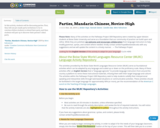
In this activity, students will be discussing parties. First, they will use pre-made party invitations to try to convince fellow students to attend their party, and then students will pair up to discover their partner’s ideal party.

A People’s History of New York City traces the history of NYC through the experiences of Immigrant and Migrant communities. By tracing common threads between these groups the City’s modern relevance, as well as its present tensions is unveiled. Highlighted are economic and social struggles for equity, justice and liberation from the marginalized groups who allowed for the creation of arguably the most significant metropolis of the present era.